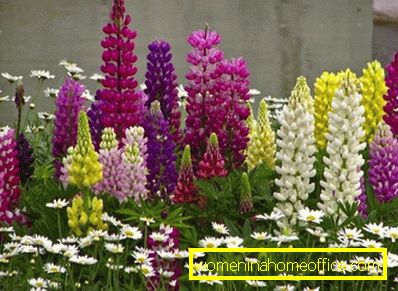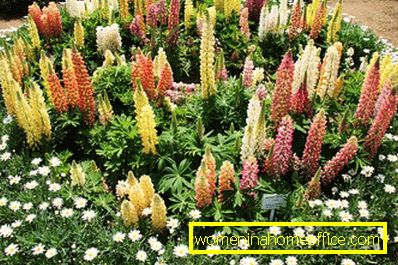Lupins
Lupins are beautiful flowers of the legume family. They are both annual and perennial. There are about 200 species of these plants. Gardeners often use blue, red, pink, white and yellow lupins to create beautiful flower arrangements. They are recommended to grow it in the gardens, and not in flower beds.
Growing and caring for lupins: basic rules

- You can grow a plant on almost any soil, but when planting it is recommended to make peat. Even sand may be suitable as a primer. The best places for planting are weakly alkaline, slightly acidic and neutral soil types. Alkali plants turn yellow. If you plant lupins in high-quality and fertilized land, they will grow much better. If planted in acidic soil, it is necessary to add lime to deoxidize it. To ensure a longer and abundant flowering, it is better to plant it in a sunny place (in the penumbra the flower will also grow).
- Lupins can be propagated by cutting. To do this, at the base of the stems, capturing part of the root collar, cut the kidney with a knife and plant it in sandy soil. Somewhere in 25-30 days, young plants will develop roots, and they can be planted in a permanent place. If you plant cuttings in the spring, take the basal rosettes that formed at the base of the stem; if you plant in the summer, side shoots formed in the leaf axils. This method is good because the lupins retain their color and appearance.
- In the first year of life, flowers practically do not require care. You will only need to loosen the soil and remove weeds. If the radical neck of the plant is exposed, you need to pour the earth. You can make mineral fertilizers. After 2 years of flowering, gardeners strongly recommend spuding the bush so that the lateral roots develop and the plant retains its decorative appearance longer.
- If the flower is grown in windy places, it is tied up so that it does not break. To prolong flowering, flowering inflorescences are removed before the seeds appear. To control the spontaneous reproduction, it is recommended to cut them.
- Watering lupins provide moderate. In the summer, especially hot, plentiful, but rare. A tree-shaped culture requires shelter for the winter.
- After 4 - 5 years of flowering, lupine bushes are removed and new ones are planted, since the old plants bloom a little, the inflorescences are not so lush and beautiful than before.
How to grow flower seed?

The technology of growing lupins from seeds is fairly simple, it is enough to know what kind of soil they prefer and when it is best to plant. Perennial crops like penumbra, slightly acidic or slightly alkaline soil. Annuals tolerate cultivation on light fertile soils.
It is better to sow lupins in April after the snow melts. Just do not forget to prepare the ground and place for flowers in the autumn. Before planting, it is recommended to treat the seeds with a 50% solution of foundationol. The first flowering can be seen about a year after planting. Germination of lupine seeds retain up to 5 years.
By the way, they can be sown in late autumn: in late October - early November, seeds are planted in open soil to a depth of 2 cm and sprinkled on top of a layer of peat so as not to freeze. If the soil is sandy, then the depth of sowing can reach up to 6-8 cm. The seeds will begin to germinate in the spring, and in early August you can already enjoy the first flowering. When planting seeds in a flower garden, keep a distance of 30 - 50 cm between them.
In addition, the seeds can be sown as seedlings, and with the onset of spring to plant in a permanent place in the soil. Land for planting should be loose, if old lupins are left, mix their tubers with the ground - this will increase the nitrogen-fixing bacteria. Watering the seedlings is moderate, and with 3 - 5 leaflets that appear, they are planted in open ground after spring frosts are bypassed.
When seed reproduction of lupins is likely to change their usual color. Purple will dominate, while white is almost lost.
What sick lupins?

The main disease for lupins is anthracnose, for the treatment of which the following fungicides should be used: mical, radomil and arcerid. Besides anthracosis, there is rust, bacterial cancer, fusarium, gray mold, powdery mildew. Rust and mealy grows by removing diseased parts of the plant, in some cases digging and liming of the soil is required. The remaining diseases should be treated with special means.
The main pests of the plant are considered to be aphids, nodule weevils, spider mites, meadow bugs, moths, slugs and nematodes. When an infection is detected, special preparations should be used to kill these pests or garlic water.
Photos of flowers





Lupine - a beautiful and bright plant, which is loved by gardeners, not only for unpretentious care. It enriches the soil area with nitrogen and cleans it from pathogens and pests. The flower can grow in any garden, at the same time, you will not put almost any effort.